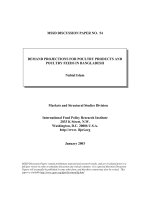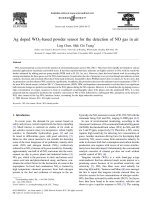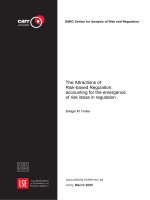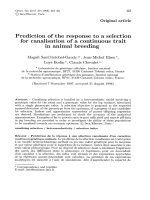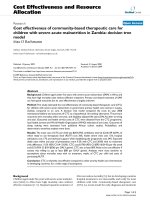Soil test crop response based fertilizer equations for Bt cotton under rainfed situation in Vertisol
Bạn đang xem bản rút gọn của tài liệu. Xem và tải ngay bản đầy đủ của tài liệu tại đây (282.04 KB, 9 trang )
Int.J.Curr.Microbiol.App.Sci (2019) 8(5): 1658-1666
International Journal of Current Microbiology and Applied Sciences
ISSN: 2319-7706 Volume 8 Number 05 (2019)
Journal homepage:
Original Research Article
/>
Soil Test Crop Response based Fertilizer Equations for
Bt Cotton under Rainfed Situation in Vertisol
T. Sherene1*, R. Santhi2 and K. Bharathi Kumar3
1
Dept. of Soil Science & Agricultural Chemistry, ADAC&RI, Trichy, TNAU, India
2
Directorate of Natural Resources Management, TNAU, Coimbatore, India
3
Cotton Research Station, Veppanthattai, TamilNadu Agricultural University,
Coimbatore, India
*Corresponding author
ABSTRACT
Keywords
Fertilizer
prescription
Equation, IPNS,
Nutrients, Soil
fertility, Vertisol
Article Info
Accepted:
15 April 2019
Available Online:
10 May 2019
Field experiments were conducted on a Typic Haplustert of Tamil Nadu by
adopting the inductive cum targeted yield model developed for Bt cotton under
rainfed situation. The basic parameters viz., NR, Cs, Cf and contribution of
nutrients from FYM were computed from the field experimental data developed in
the previous cropping season. Using these basic parameters, fertilizer prescription
equations were developed under the Integrated Plant Nutrition System (IPNS) and
nomograms were formulated for the desired yield target of Bt cotton for a range of
soil test values. The quantity of nutrients that could be contributed by FYM at 12.5
t ha-1 was evaluated as 25, 20 and 26 kg N, P2O5 and potassium oxide K2O
respectively, when applied along with the NPK fertilizers as per soil test and
desired yield target. The fertilizer prescription equations developed for Bt cotton
proved their validity under six numbers of farmer’s holdings under rainfed
situation.
Introduction
In the era of precision agriculture, application
of fertilizers based on soil testing is an
essential tool to prescribe nutrient doses for
crops besides assessing soil health. Further,
the escalation in fertilizer prices has caused a
serious set back for balanced fertilization. At
present, an annual net negative balance of
about 8-10 million tons of nutrients per
annum is reported in India. This distortion in
soil fertility and deterioration in soil health is
due to indiscriminate and imbalanced use of
fertilizers and it can be corrected only with
proper manure – fertilizer schedule based on
soil fertility evaluation.
Concomitant with the steep increase in
adoption of private sector Bt cotton hybrids
from the year 2002 onwards and also
improved cotton production technologies
besides good public sector hybrids, the
1658
Int.J.Curr.Microbiol.App.Sci (2019) 8(5): 1658-1666
average productivity has increased from 308
kg ha -1 to 550 kg ha-1 in India. Perambalur is
the leading District in Bt cotton cultivation
and is cultivated in an area of 22,000 ha. At
this juncture, the unique inductive cum
targeted yield model of Ramamoorthy et al.,
(1967) is quite appropriate for determining a
precise fertilizer prescription for Bt cotton
under rainfed situation. Hence present study
has been undertaken on black calcareous soils
(Typic Haplustert) of TamilNadu.
Materials and Methods
A field experiment was conducted with Bt
cotton var. Brahma BG (II) during 2011-2012
on Typic Haplustert at gotton research station
farm, veppanthattai, Tamil Nadu Agricultural
University, Coimbatore. The surface soil of
the experimental field is black calcareous,
very deep, moderately drained, clay loam in
texture with pH 8.45, electrical conductivity
(EC) 0.47 dSm-1, and cation exchange
capacity of 27.7 cmol (p+) kg-1. The initial
soil
available
alkaline
potassium
permanganate (KMnO4) nitrogen (N), organic
carbon, Olsen phosphorus (P), and
ammonium acetate (NH4OAc) K were 146kg
ha-1, 0.42%, 11 kg ha-1 and 124 kg ha-1
respectively. The P and K- fixing capacities
of the soil were 345 and 96 kg ha-1
respectively. The available iron (Fe),
manganese (Mn), zinc (Zn) and copper (Cu)
were in the sufficiency ranges. Variation in
soil fertility was created by adopting the
inductive methodology developed by
Ramamoorthy et al., (1967). The experiment
was laid out in a fractional design comprising
twenty- four treatments with four level of N
(0,30,60 and 90 kg ha-1), four levels of P2O5
(0,15,30 and 45 kg ha-1), four levels of K2O
(0,30,60 and 90 kg ha-1), and three levels of
FYM (0,6.25, and 12.5t ha-1). The IPNS
treatments (NPK alone, NPK+ FYM at 6.25 t
ha-1, and NPK+ FYM 12.5 t ha-1) were
superimposed across the strips. The 21
fertilizer treatments and three controls were
randomized in such a way that all the 24
treatments were present in all the three strips
on either direction. The treatment structure is
given in table 1. Making use of the data on
nutrient uptake, seed cotton yield, pre-sowing
soil available N,P and K nutrients, and
applied fertilizer doses, the basic parameters
[viz., nutrient requirement (NR), contributions
of nutrient from soil (Cs) and fertilizers (Cf)]
were calculated as outlined by Ramamoorthy
et al., (1967) and those from FYM (Cfym)
were estimated as described by Santhi et al.,
(1999).
Yield targeted equations
From the above parameters the yield targeted
equations were as given below:
(a) Under NPK alone
(i)FN =
NR
------ T
Cf/100
-
Cs
-----Cf
-
Cs
-----Cf
SN
(b)Under IPNS
a)(i)FN=
NR
------ T
Cf/100
SN
1659
-
Cfym
------ ON
Cf
Int.J.Curr.Microbiol.App.Sci (2019) 8(5): 1658-1666
b)(i) F P2O5
=
NR
------ T
Cf/100
-
Cs
-----Cf
a)(ii) F P2O5
=
NR
------ TCf/100
Cs
-----Cf
Cfym
x 2.29 x SP- ------ x2.29 x OP
Cf
a)(iii) F K2O =
NR
------ T
Cf/100
-
Cs
-----Cf
x 1.21 x SK
b)(iii). F K2O =
NR
------ T
Cf/100
-
Cs
-----Cf
x 1.21 x SK
Where,
FN=Fertilizer N in kg ha-1
F P2O5 =Fertilizer P2O5 in kg ha-1
F K2O =Fertilizer K2O in kg ha-1
T = yield target in q ha-1
NR=Nutrient requirement N or P2O5 or K2O
kg q-1
Cs=Per cent contribution of nutrients from
soil
Cf=Per cent contribution of nutrients from
fertilizer
Cfym= Per cent contribution of nutrients from
FYM
SN=Soil test value for available N in (kg ha-1)
SP=Soil test value for available P in (kg ha-1)
SK=Soil test value for available K in (kg ha-1)
ON,OP and OK are the quantities of N,P and
K supplied through FYM in kg ha-1
x 2.29 x SP
Cfym
- ----- x 1.21 x OK
Cf
rainfed situation. The treatments followed
were
i)
ii)
iii)
iv)
v)
vi)
vii)
Control
Blanket recommendation
STCR 28 q ha-1
STCR 32 q ha-1
STCR - IPNS 28 q ha-1
STCR - IPNS 32 q ha-1
Farmer’s practice.
The Bt cotton, BRAHMA BG II was sown
during September 2012 and harvested on
March -2013. The fertilizer doses applied,
seed cotton yield, per cent achievement and
response ratio of targeted yield are discussed
below.
Results and Discussion
These equations serve as a basis for predicting
fertilizer doses for specific yield targets (T)
for varied soil available nutrient levels.
Seed cotton
nutrients
Confirmatory test verification trials were
conducted at various blocks of Perambalur
district representing Pilamedu soil series viz.,
Palayur, CRS farm, Nerkunam, Esanai,
Perambalur and Venbavour villages, to
confirm the validity of fertilizer prescription
equations developed for Bt cotton under
The mean seed cotton yields of rainfed Bt
cotton were 1354, 1902 and 2739 kg ha-1 in
strip I, II and III respectively. The N uptake
ranged from 14.08 to 83.49 kg ha-1; P uptake
ranged from 1.03 to 15.15 kg ha-1 and The K
uptake ranged from 10.33 to 80.22 kg ha-1 in
strip I - III respectively. The data on initial
1660
yield
and
soil
available
Int.J.Curr.Microbiol.App.Sci (2019) 8(5): 1658-1666
soil test values revealed that mean KMnO4 –N
values were 146 kg ha-1 in strip I, 176 kg ha1
in strip II and 194 kg ha-1 in strip III. The
mean Olsen –P values were 10.34, 20.75 and
29.27 kg ha-1 in strip I, II and III respectively.
The mean NH4OAc –K values were 123, 174
and 214 kg ha-1 in strip I, II and III
respectively.
The existence of operational range of soil test
values for soil available N, P and K status in
the present investigation was clearly depicted
from the initial soil available nutrient status
and the variation in the seed cotton yield and
NPK uptake, which is a pre requisite for
calculating the basic parameters and fertilizer
prescription equations for calibrating the
fertilizer doses for specific yield target. Santhi
et al., (2011) reported similar existence of
operational ranges of available N, P and K for
beetroot on Alfisol.
K20 were reported by Smitha John (2004) for
cabbage and Santhi et al., (2011) for beet root
(Table 2).
Percentage Contribution of nutrients from
soil (Cs), Fertilizers (Cf), and Farm yard
manure (Cfym) to Total Uptake
The percentage contribution of nutrients from
soil (Cs) to the total uptake was computed
from the absolute control. In the present
study, it was found that the soil has
contributed 11.08% of available N, 18.60% of
available P, and 8.66 % of available K
respectively toward the total N, P, and K
uptake by beetroot. Among the three
nutrients, the percentage contribution from
soil was relatively higher for P followed by N
and K.
Nutrient Requirement (NR)
With regard to fertilizer nutrients (Cf), the
contribution was computed from NPKapplied plots, and the values were 46.34 %,
21.35 %, and 81.40 %, respectively for N,
P2O5, and K2O in which the contribution from
applied fertilizer followed the order of K2O >
N> P2O5. The estimated Cf clearly revealed
that the magnitude of contribution by
fertilizer K2O was 4.14 times greater than
P2O5 and 2.12 times that of N. With regard to
N, P2O5, and K2O, comparatively greater
contribution was recorded from fertilizers
than from the soil. With regard to K2O,
comparatively less Cs was recorded, which
might be due to the preferential nature of Bt
cotton toward the applied K2O than the native
K2O.
The results of the present investigation
revealed that Bt cotton under rainfed situation
requires 2.48 kg of N, 0.78 kg of P2O5, and
3.12 kg of K20 for producing one quintal of
seed cotton (Table 3). Among the three
nutrients, the requirement of K2O is relatively
higher; followed by N and P2O5. Similar
trends of nutrient requirement for N, P2O5 and
The percentage contribution of nutrients from
farm yard manure (Cfym) to the total uptake
was computed from the farm yard manure
applied plots. It was found that farm yard
manure has contributed 24.58 % of N, 7.81 %
of P2O5 and 36.87 % of K2O respectively
toward the total N, P, and K uptake by rainfed
Bt cotton following the order N > K2O >
Basic parameters
In the targeted yield model, making use of the
data on yield of Bt cotton, uptake of NPK,
initial soil test values, and the doses of
fertiliser N, P2O5, and K2O applied, the basic
parameters were computed. The basic
parameters
for
developing
fertilizer
prescription equations for Bt cotton are (i)
nutrient requirement in kg per quintal of seed
cotton yield (NR) and percentage contribution
of nutrients from soil (Cs), fertilisers (Cf), and
farm yard manure (Co).
1661
Int.J.Curr.Microbiol.App.Sci (2019) 8(5): 1658-1666
P2O5. Similar trends for Cs, Cf, and Co for N,
P2O5, and K20 were reported by
Vijayalakshmi (2008) for radish on Typic
Haplustalf.
Fertilizer prescription equations
Soil test based fertilizer prescription equations
for desired yield target of Bt cotton under
rainfed situation were formulated using the
above said basic parameters
NPK alone
FN
= 5.35 T – 0.24 SN
FP2O5 = 3.67 T - 1.99 SP
FK2O = 3.83 T – 0.13 SK
NPK with farm yard manure
of 32 q ha-1of seed cotton yield with soil test
values of 275: 24: 400 kg ha-1 of KMnO4 –N,
Olsen-P and NH4OAc–K, the fertilizer N,
P2O5 and K2O doses were 106, 70 and 71 kg
ha-1 respectively. When FYM (26 % moisture,
0.51 %, 0.25 % and 0.50 % N, P and K) at
12.5 t ha-1 was applied along with NPK, the
required fertilizer N, P2O5 and K20 doses
were 81, 50 and 44 kg ha-1 respectively.
Under IPNS, the savings of fertilizer N, P2O5
and K2O were 93, 60 and 51 kg ha-1
respectively for NPK plus FYM @ 6.25 t ha-1
and 25, 20 and 26 kg ha-1 for NPK plus FYM
@ 12.5 t ha-1 respectively. These quantities of
nutrients can be reduced from the
recommended doses of fertilizers for a
particular soil test value and yield target.
Results of confirmatory test verification
trials
FN
= 5.35 T – 0.24 SN – 0.53 ON
FP2O5 = 3.67 T - 1.99 SP – 0.84 OP
FK2O = 3.83 T – 0.13 SK - 0.55 OK
where, FN, FP2O5 and FK2O respectively are
fertilizer N, P205 and K20 in kg ha-1; T is the
yield target in q ha-1 and SN, SP and SK
respectively are alkaline KMnO4–N, Olsen
and NH4OAc–K in kg ha-1. ON, OP and OK
are quantities of N, P and K supplied through
FYM in kg ha-1. Santhi et al., (2012)
documented the formulation of fertilizer
prescription equations for expand various
agriculture and horticulture crops of
TamilNadu.
Fertilizer prescription under IPNS for
desired yield target of Bt cotton under
Rainfed situation
A ready reokoner was prepared based on
these equations for a range of soil test values
and for yield target of 32 q ha-1(Table 3). The
data clearly revealed the fact that fertilizer N,
P2O5 and K2O requirements decreased with
increase in soil test values. For a yield target
The per cent achievement of the targeted yield
was within +/- 10 per cent variation in all the
locations for both the yield targets under NPK
alone and IPNS proving the validity of the
equations. Among the different treatments
followed, STCR-IPNS - 32 q ha-1 has
recorded the highest yield of 32.58, 32.85,
32.38 and 32.85 q ha-1 at Nerkunam, Esanai,
Venbavour and Perambalur trials respectively
(Tables 1 and 4). The highest response ratio
of 4.57, 4.14, 4.43 and 4.92 kg kg-1 were also
recorded in the STCR-IPNS-32 q ha-1
treatments at Nerkunam, Esanai, Venbavour
and Perambalur trials respectively. Farmer’s
practice recorded relatively lower yield (20.75
q ha-1) and response ratio (1.56 kg kg-1) as
compared to blanket and STCR treatments.
While the STCR - IPNS treatments recorded
the highest per cent achievement and response
ratio among all the treatments. Though the
blanket fertiliser recommendation recorded
relatively higher yield and response ratio over
farmer's practice, it was lower when
compared to STCR treatments. STCR-IPNS
for 32 q ha-1 has recorded a yield increase of
1662
Int.J.Curr.Microbiol.App.Sci (2019) 8(5): 1658-1666
46.7 per cent over blanket and 57.5 per cent
over farmer’s practice (Table 4). The mean
data of the four locations revealed that STCRIPNS based fertilizer recommendations for an
yield target of 32 q ha-1 has recorded the
highest mean seed cotton yield of 32.67 q
ha-1, response ratio of 4.52 kg seed cotton
yield kg-1 fertilizer applied, per cent
achievement of 102.0 Sherene et al., (2006)
(Table 3).
Table.1 Treatment structure for test crop experiment on Bt cotton
S.
No
1.
2.
3.
4.
5.
6.
7.
8.
9.
10.
11.
12.
13.
14.
15.
16.
17.
18.
19.
20.
21.
22.
23.
24.
Level of Nutrients kg ha-1
N
P2O5
K2O
0
0
0
0
0
0
0
0
0
0
30
60
30
15
30
30
15
60
30
30
30
30
30
60
60
15
30
60
0
60
60
15
60
60
30
0
60
30
30
60
30
60
60
30
90
60
45
60
60
45
90
90
15
30
90
30
30
90
30
60
90
45
30
90
45
60
90
30
90
90
45
90
Treatment Combinations
N
P
K
0
0
0
0
0
0
0
0
0
0
2
2
1
1
1
1
1
2
1
2
1
1
2
2
2
1
1
2
0
2
2
1
2
2
2
0
2
2
1
2
2
2
2
2
3
2
3
2
2
3
3
3
1
1
3
2
1
3
2
2
3
3
1
3
3
2
3
2
3
3
3
3
Table.2 Nutrient requirement, percent contribution of nutrients from soil and fertilizer for
rainfed Bt cotton
Parameters
Nutrient requirement (kg /q)
Percent contribution from soil (Cs)
Percent contribution from fertilizers (Cf)
Percent contribution from FYM (Cfym)
1663
Basic data
N
P 2 O5
2.48
0.78
11.08
18.60
46.34
21.35
24.58
7.81
K2O
3.12
8.66
81.40
36.87
Int.J.Curr.Microbiol.App.Sci (2019) 8(5): 1658-1666
Table.3 Soil test based fertilizer prescriptions under IPNS for 32 q ha-1 target seed cotton yield
of Bt cotton under rainfed situation (kg ha-1)
NPK alone
kg /ha
KMnO4 –N (kg ha-1)
100
125
150
175
200
225
250
275
Olsen P (kg ha-1)
10
12
14
16
18
20
22
24
NH4OAc -K (kg ha-1)
100
150
200
250
300
350
400
450
NPK plus
FYM @6.25 t
/ha
(kg /ha)
IPNS
Percent
reduction over
NPK alone
NPK +FYM
@12.5 t /ha
Percent
reduction over
NPK alone
147.2
141.2
135.2
129.2
123.2
117.2
111.2
105.2
134.61
128.61
122.61
116.61
110.61
104.61
98.61
92.61
8.55
8.92
9.31
9.74
10.22
10.74
11.32
11.97
122.0
116.0
110.0
104.0
98.03
92.03
86.03
80.03
17.09
17.82
18.61
19.48
20.43
21.47
22.63
23.93
97.54
93.56
89.58
85.6
81.62
77.64
73.66
69.68
87.56
83.58
79.60
75.62
71.64
67.66
63.68
59.70
10.23
10.66
11.14
11.65
12.22
12.85
13.54
14.32
77.59
73.61
69.63
65.65
61.67
57.69
53.71
49.73
20.45
21.32
22.27
23.30
24.44
25.69
27.08
28.63
109.5
103.0
96.56
90.06
83.56
77.06
70.56
64.06
96.4
89.9
83.46
76.96
70.46
63.96
57.46
50.96
11.96
12.71
13.56
14.54
15.67
16.99
18.56
20.44
83.43
76.93
70.43
63.93
57.43
50.93
44.43
37.93
23.80
25.31
27.06
29.01
31.27
33.90
37.03
40.78
Table.4 Results of four confirmatory trials on rainfed Bt cotton
.
S.No.
1.
2.
3.
4.
5.
6.
7.
Treatments
Nutrients added (kg ha-1)
N
P2O5
K2O
Control
0
Blanket
60
STCR –NPK alone 28 q ha-1
96-113
STCR –NPK alone 32 q ha-1
118-135
STCR -IPNS 28 q ha-1
71-88
STCR -IPNS 32 q ha-1
93-109
Farmer’s practice
49
Fertilizer Prescription Equations
FN
= 5.35 T – 0.24 SN – 0.53 ON
FP2O5 = 3.67 T - 1.99 SP – 0.84 OP
FK2O = 3.83 T – 0.13 SK - 0.55 OK
0
30
60
60
60
59 -96
25
1664
0
60
51-85
66-100
25-59
40-75
37
Mean
Seed cotton yield
(q ha-1)
18.92
22.28
26.67
30.61
28.49
32.67
20.75
Mean
Achievement
(%)
95.23
95.64
101.74
102.1
-
Mean
RR
2.16
3.83
3.77
4.52
1.56
Int.J.Curr.Microbiol.App.Sci (2019) 8(5): 1658-1666
STCR-IPNS based fertilizer recommendations
for a yield target of 32 q ha-1 has recorded the
highest yield, response ratio and per cent
achievement. Therefore, the fertilizer
prescription equations developed for Bt cotton
under IPNS can be recommended for black
calcareous soils with an yield target of 32 q
ha-1 under rainfed situation
In conclusion, soil test based fertilizer
prescription for Bt cotton under rainfed
situation was developed on Typic Haplustert
soil of Tamil Nadu taking into account the
nutrient requirement and contributions of
NPK from the nutrient sources (soil, fertilizer
and FYM). This allows the balanced supply
of nutrients through IPNS.
Acknowledgements
The authors are very much thankful to M/S.
Mahyco Monsanto Bio Tech. India Ltd. for
providing financial assistance and AICRP –
STCR, TNAU, Coimbatore centre for
technical guidance to execute this work for
the welfare of Bt cotton growers of rainfed
tract of Tamil Nadu.
References
Humphries, E.C. (1956): Mineral components
and ash analysis: Modern methods of
plant analysis, Vol. 1, 468- 562. Berlin:
Springer- Verlag.
Jackson, M.L. (1973): Soil chemical analysis.
New Delhi, India: Prentice Hall of
India.
Olsen, S.R., Cole, C.V., Watanabe, F.S and
Dean, L. (1954): Estimation of available
phosphorus in soils by extraction with
sodium bicarbonate (USDA Circular
939).
Washington,
D.C:U.S.
Government Printing office.
Paulraj, C., Natarajan, S., Subba Rao, A. and
Muralidharudu, Y. (2007): Technical
bulletin on soil test crop response based
fertilizer prescription for different soils
and crops in Tamil Nadu, TamilNadu
Agricultural University, India.
Ramamoorthy, B., Narasimhan, R.L and
Dinesh,
R.S.
(1967):
Fertilizer
application for specific yield targets on
Sonora 64 (wheat). Indian farming 17:
43-45.
Santhi, R., Selvakumari, G and Rani Perumal.
(1999): Soil Test based fertilizer
recommendations under integrated plant
nutrition system for rice –rice –pulse
cropping sequence. Journal of Indian
society of soil science 47 (2): 288-294.
Santhi, R., Baskaran, R. and Natesan, R.
(2011): Integrated Fertilizer prescription
equations for Beet Root through
Inductive cum Targeted Yield model on
an Alfisol. Communications in Soil
Science and Plant Analysis, 42:16, 1905
-1912.
Smitha John, K. (2004): Soil test crop
response correlation studies under
integrated plant nutrition system for
cabbage (Brassica oleracea l. var
capitata) on Inceptisols. M.Sc. (Ag.)
thesis,
TamilNadu
Agricultural
University, India.
Sherene, T, R.Santhi, R.Kavimani and K.
Bharathikumar.
2016.
Integrated
Fertilizer Prescriptions for transgenic
cotton hybrids under rainfed situation
through Inductive cum Targeted yield
model on Vertisols. Communications in
Soil Science and plant analysis.Vol.47,
No.17, 1951 -1960.
Stanford, S and English, L. (1949): Use flame
photometer in rapid soil test of K and
Ca. Agronomy Journal. 41: 446.
Subbiah, B.V., and Asija, G.L. (1956): A
rapid procedure for estimation of
available nitrogen in soil. Current
science 25: 259-260.
Uma Devi, R. (2005): Soil test crop response
correlation studies under integrated
plant nutrient system for carrot for
1665
Int.J.Curr.Microbiol.App.Sci (2019) 8(5): 1658-1666
Alfisol. M.Sc. (Ag) thesis, TamilNadu
Agricultural University, India
Vijayalakshmi, K. (2008). Soil test crop
response studies on radish under
integrated plant nutrition system. M.Sc.
(Ag) thesis, TamilNadu Agricultural
University, India.
How to cite this article:
Sherene, T., R. Santhi and Bharathi Kumar, K. 2019. Soil Test Crop Response based Fertilizer
Equations for Bt Cotton Under Rainfed Situation in Vertisol. Int.J.Curr.Microbiol.App.Sci.
8(05): 1658-1666. doi: />
1666
